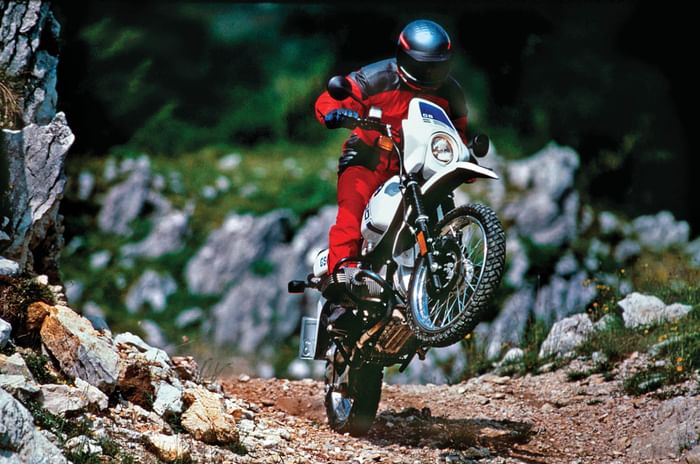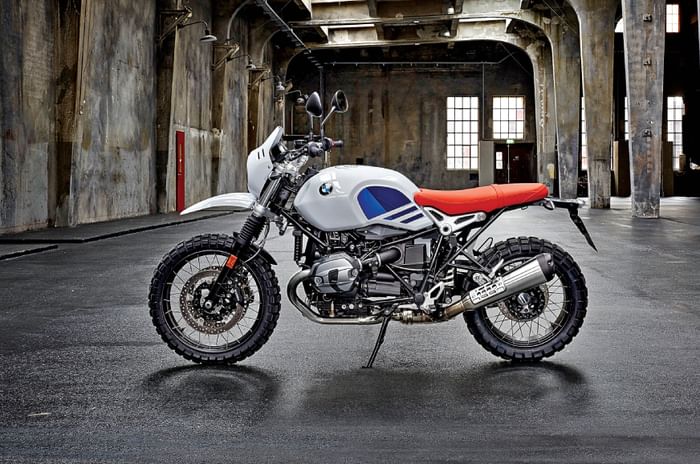Standing Tall: 40 years of the BMW GS
One of the most important motorcycle lines of the modern era turned 40 this year. We take you through the journey of the mighty BMW GS.
Published On Aug 21, 2020 08:00:00 AM
26,840 Views
Follow us onIf you go back a couple of decades, there was a time when the premium motorcycle business was ruled by sports bikes. But over the years, adventure bikes steadily got bigger and bigger (figuratively and literally), and today’s premium motorcycle business has ADVs sitting at the very top. And this isn’t just some mature market phenomenon because the clamour for ADVs is getting louder in emerging markets like ours as well. One bike stands at the root of this movement, and 2020 marks the 40th years of its existence. And that’s the mighty BMW GS.
Origin story
The story of the GS can be traced back to the late ’70s, a time when BMW Motorrad wasn’t the powerhouse it is today. In those days, the company had an ageing line-up of horizontally-opposed twin-cylinder-engined (also known as the boxer) machines, and its very existence was under question. This was around the time when some BMW engineers were making their own boxer-engined off-road bikes in their spare time, but it was something the company wasn’t taking seriously. Almost simultaneously, BMW designer Hans Muth was experimenting with his own ideas and was working with an existing R 65 motorcycle frame with a bigger 797cc boxer engine from the R 80/7. What Muth was working on was essentially a sort of big off-roader that could cover distances as well.

This was a completely alien concept at the time because, while there were plenty of tourers and a host of enduro bikes, there was nothing that claimed to do both. Meanwhile, what also helped the G/S’ cause was that in the late ’70s, the German Enduro championship had created a new 750cc+ category which allowed such machines to race. At the hands of the company engineers and test riders who raced in their personal time, the aforementioned home-built off-road boxers happened to perform quite well. With the platform’s ability proven, and Muth’s own project underway, BMW greenlit the project.
In 1980, the R 80 G/S was unveiled to the world, with the official definition for the initials being ‘Gelande’ (terrain) and ‘Strasse’ (road). Despite the public never having seen anything like this before, the bike ended up doing better than the company expected in its first year, with over 6,500 units being sold. As for Muth, he didn’t stay with BMW for long and moved on to work with Suzuki to design another all-time icon, the 1981 Katana.
The legend grows
Not content with having created what was probably the world’s first ‘adventure motorcycle’ (although the category was known as the touring-enduro back then), BMW went on to prove that its machine could walk the talk. A rally-prepared version the R 80 G/S was entered in the 1980 edition of the mighty Paris Dakar Rally, and with an enormous 9,500km to cover – through various forms of terrain – this was the bike’s time to shine. In its first year, the bike finished 5th, which prompted BMW to return the next year with a more serious team and motorcycle. This time, with MX rider Hubert Auriol, the R 80 G/S absolutely destroyed the competition, winning with a four-hour margin over the rider in second place! The G/S then went on to bag three consecutive wins in 1983, 1984 and 1985. These bikes were the true beasts of Dakar, especially the heavily modified 1985 winning bike, which ran a massive 1,000cc engine. In comparison, today’s Dakar bikes are limited to 450cc singles. On the other side of the pond, BMW also took the GS to the famous Baja Rally in America and picked up victories in 1982 and 1983.

To commemorate its motorsports victories, a special R 80 G/S Paris Dakar edition was launched with a 32-litre fuel tank signed by Belgian rider Gaston Rahier. Regular followers of Autocar India will remember that we were lucky enough to actually ride one of these on the streets of Mumbai!
In 1987 came the first all-new model, the R 100 GS. This bike got a bigger 980cc engine that made about 60hp, compared with the 50hp from the R 80 G/S. It also received plenty of changes that marked the course of evolution for the GS brand. BMW found that most customers spent their time on tarmac (some things never change), so things like the 18-inch rear wheel were now changed to 17-inches. Customers also complained that the R 80 G/S’ monolever rear suspension (essentially a single-side swingarm with shaft drive) caused the trademark shaft drive tendency to ‘jack up’ under acceleration, which led to... erm, quirky dynamics. The solution was the new ‘paralever’ which created a dual-link from the transmission to the wheel. Overall, the R 100 GS was bigger and heavier than the bike before it, but the better road manners meant the public loved it regardless - sounds familiar?

Meanwhile, the R 80 G/S made way for the new R 80 GS which received similar updates as the R 100, including the use of cross-spoked wheels that allowed the use of tubeless tyres; something that’s a rarity on adventure bikes even today! A smaller R 65 GS also came out at around the same time with the smaller 650cc boxer from the R 65, but this bike never enjoyed the same popularity as its bigger siblings.
And grows some more
The mighty GS began to take the shape we know today with the all-new R 1100 GS that debuted in 1994. With a stance more in line with modernday ADVs, the R 1100 GS was a significant stride forward for the GS brand. Its new 1,085cc motor featured an oil-cooling setup and it was the first GS to use fuel injection. The old two-valve pushrod design was also swapped for a modern, cam-driven four-valve setup.
Perhaps the biggest change came in the front suspension design, where the traditional fork was replaced by BMW’s Telelever front end. This uses a centrally mounted shock and creates a rather unique riding experience with very little dive under braking. The GS uses this setup to this day, and it’s just another factor that makes it stand out in a sea of bikes that were born to compete with it.

Of course, the R 1100 GS was bigger and more advanced than the bike it replaced. This trend has continued with the R 1150 GS that replaced it in 1999 and brought with it a 6-speed transmission for the first time. What the 1150 will be most remembered for was the near36,000km ride from London to New York by Ewan McGregor and Charley Boorman, and the subsequent TV show and book, both titled ‘Long Way Round’ based on it. This show was widely credited for converting the GS’ image from an old man’s bike to a cool and desirable object for those who craved for a life of adventure. The inside story is that the original choice was to do this with KTMs, but the Austrian company didn’t provide them bikes, so the team turned to BMW instead. Who knows what today’s ADV market might have looked like if KTM had agreed!

In 2004, the R 1200 GS was launched, and this model finally broke the trend by being a whole 30kg lighter than the model it replaced. This was also the first GS to hit the 100hp mark. The year 2005 saw the debut of the R 1200 GS Adventure, which was a more long-distance-focused sister model that boasted a bigger fuel tank – a nod to the original R 80 G/S Paris Dakar edition. The GS Adventure line has been available since.
More updates emerged over the years, from electronic stability control and electronically controlled suspension in 2008, to the shift to DOHC layout in 2010 and the introduction of water cooling for the now infamous 2013 model. This bike was subject to multiple recalls and BMW even had to subsequently revise the steering geometry due to complaints of poor stability. The last big GS update came in 2017 with the introduction of the current R 1250 GS that featured a bigger motor with variable valve timing that now pushed out 136hp.

The full picture
In this story, we’ve focused on boxer-powered GS models because, while there have been multiple single-cylinder and parallel-twin engined GSes over the years, the boxer has always been the essence of this bike. That being said, today’s 250kg, windproof luxury barges are a far cry from the original R 80 G/S; although, you could argue that the intention behind the bike’s existence has remained the same. In many ways, the 2018 R nine T Urban GS, with its standard telescopic fork, is a much closer modern representation of the 1980 original, at least visually. Nevertheless, in the last 40 years, the GS has become the most important bike the German manufacturer has ever made. It’s been the company’s bestseller for decades, and even today, it is the top-selling motorcycle in markets like the UK. After all these years, and despite all the competition that has emerged, the GS has remained a highly capable, yet unique and soulful machine that will get you to the cafe in complete comfort, whether it’s down the street or on the other side of the world. Long live the GS!

Copyright (c) Autocar India. All rights reserved.







Comments
Member Login
Personal Details
No comments yet. Be the first to comment.